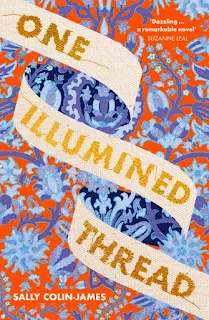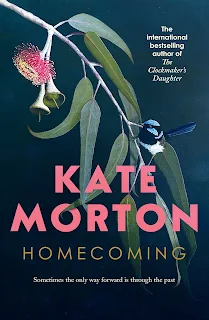* Copy courtesy of Harper Collins *
One Illumined Thread by Sally Colin-James is an historical fiction novel about the lives of three women linked across three very different timelines. In Hebron, 41 BCE Elisheva is a married woman ostracised by her community because she's been unable to bear a child. Antonia is the wife of an artist in Renaissance Florence and we pick up her thread (pun intended) in 1497. Our contemporary narrator is Doctor Reed, a textile conservator living in Adelaide in 2018 and all three characters were compelling.
Establishing the unique identity of each of the three main characters was a little tough at first, but I was helped along by the talented writing of Colin-James and her ability to keep re-introducing characters to the reader in a helpful manner reminiscent of Philippa Gregory.
Fertility, motherhood and womanhood are key themes in each of the narrative arcs:
"That's us women. Often invisible. But strong like the wind. And most men, if asked for the truth, would say that when it comes to the household they sail to conditions." I didn't understand what she meant until many years later. Page 226Connecting the lives of these women across the centuries are artisan crafts, primarily glassblowing and painting. In the Judean timeline, Elisheva shakes off the disapproval of the women in her village to become a talented glassblower, with her work based on the history of Hebron glass.
The narrative set in Florence is based heavily around the painting La Visitazione by Mariotto Albertinelli (1503) which features the visitation of the Virgin Mary to Elizabeth. Antonia is married to Albertinelli and friends with Michel (Michelangelo) and is passionate about her pursuit of the perfect white.
"Without white there is no moon," he declaimed. "No stars in our night sky, no flour for our bread, no lilies for our vases. No clouds, no mists, no sudden snowstorms, no mountains of marble." ... "White is where a painter begins and where his brush ends, on the gleam of an eye: a touch of white on that black pupil is what brings the portrait to life. Without white there is no art!" Page 271Flitting between chapters about artists in Florence grinding pigments in the time of Savonarola, and the threats of violence by King Herod's Army, it was a relief to rejoin our conservator in the somewhat safer space at the Adelaide International Gallery.
Each of the women is striving to reach their inner potential, and the reader will identify with the struggles they face, even if they're of another time and place. There is plenty of character growth and development here with character insights along the way. I particularly related to this one:
"Sometimes, as children, we make too much of the people who pass through our lives. They seem grand and beautiful in the context of our world, but really they're just like every other human. Preposterous and vain." Page 193Those familiar with their history will be rewarded when reading the narrative set in Judea under King Herod's rule, and it's clear - although not obvious - how much time and effort has been invested in the research for this novel.
One Illumined Thread by Sally Colin-James is a solid debut and I agree with the publisher's recommendation that it will appeal to readers of Maggie O'Farrell and Pip Williams. Here's a phrase I particularly enjoyed that immediately put me in mind of Hamnet or The Marriage Portrait by Maggie O'Farrell.
"My mother casts me a glance sharp enough to slice onions." Page 18When I see sharp (pun intended) writing like this by a debut author - and an Australian author no less - I'm excited to imagine the pages she will write in the future. Sally Colin-James expertly weaves (sorry, couldn't help it) all three narratives of One Illumined Thread together in a meaningful and satisfying conclusion that I can highly recommend to fans of historical fiction.






































